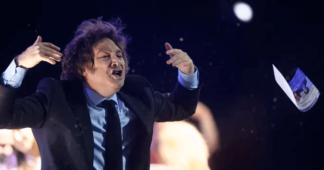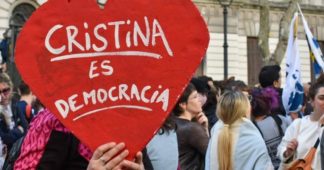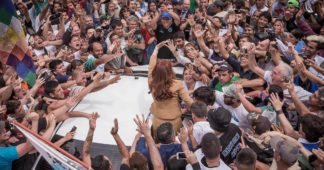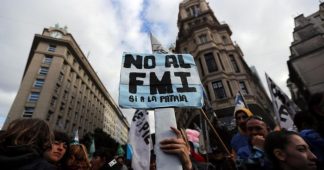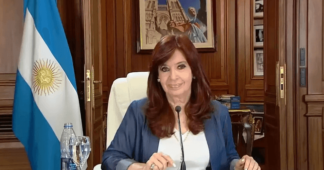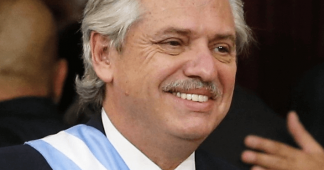By Pablo Pryluka
11 January 2023
On the night of 1 September 2022, around 9:30pm, the news began to spread like wildfire, first on social media and later on every TV channel and radio station in the country: someone had tried to kill Cristina Fernández de Kirchner (CFK), the current vice-president and former president of Argentina. Earlier that evening, a crowd of kirchneristas had come together in the well-to-do neighborhood of Recoleta in Buenos Aires to support CFK amid her ongoing corruption trial, which they saw as a classic case of lawfare orchestrated by political elites. At 9:15pm, CFK’s car pulled up in front of her house and she stepped out to greet the crowd. Suddenly, a man approached her, held out a 7.5mm Versa semi-automatic weapon and pulled the trigger – but the gun failed to go off.
After the would-be assassin was apprehended, the episode gradually faded from the headlines and the public moved on. Yet the attack reflected a significant change in Argentinian politics. CFK’s assailant, 35-year-old Fernando Sabag Montiel, is a supporter of the reactionary upstart Javier Milei – a former media personality and economics professor who recently entered mainstream politics. His coalition La Libertad Avanza performed surprisingly well in the 2021 primary elections in Buenos Aires, running on an ultra-conservative platform that nostalgized Argentina’s military dictatorship. The ability of such forces to inspire acts of violence signals an alarming historical regression. Far-right discourses that had been almost eradicated from the public sphere following the democratic transition of 1983 have now been reanimated. To understand how this has happened, it is necessary to recap on the contested legacy of Peronism and examine its role in the current Argentinian conjuncture.
*
The election of Juan Domingo Perón in February 1946 was a turning point for Argentina: a rebuke to an ossified political establishment that refused to recognize the demands of a growing layer of urban workers. Perón was already popular thanks to his record as Labour Secretary between 1943 and 1945. As president, he enacted unprecedented income redistribution while greatly expanding the welfare state, and was reelected in 1951 with 63.51% of the vote – the highest share in national history.
This broad support base allowed him to integrate trade unions into the state structure, which limited their autonomy and consolidated the power of his Justicialist Party. Indeed, Peronism grew in direct proportion to the cooptation or repression of previous union leaders, especially those with Socialist or Communist affiliations. During his decade in power, he took an authoritarian approach to opponents across the political spectrum, shuttering newspapers and persecuting activist groups. Yet his popularity remained high thanks to strong growth rates and continued progressive policies.
The economy began to show signs of exhaustion in 1949, however, as inflation rose following the depletion of Argentina’s foreign exchange reserves – precipitating a turn to austerity. This downward trend, alongside increasing conflict between Peronism and the Catholic church, provided the pretext for a major backlash from domestic elites and significant factions of the military. In September 1955, Perón was overthrown in a right-wing putsch and a military dictatorship was installed. The coup-makers presented Peronism as a populist virus that had poisoned the otherwise prosperous Argentina of the 1940s. The leader was exiled, the Judicialist Party was proscribed, and it became illegal to so much as mention his name or that of the former First Lady Eva Perón.
For more than fifteen years, Argentina alternated between military regimes and ‘democratic’ governments while Peronism remained banned. During the 1960s, political violence became a fact of daily life, as the leftist People’s Revolutionary Army and Montoneros expanded their guerrilla activities while the Argentine Anticommunist Alliance meted out paramilitary repression in coordination with the state. The Peronist youth were radicalized to the left, and called on the exiled president to return home and resolve the crisis. In 1973 they got their wish. Perón flew back to Argentina, won the national elections and reassumed high office. Yet he died of a heart attack the following year, and his widow Isabel Martínez de Perón came to power amid a turbulent economic situation and an uptick in political conflict.
The resultant disorder paved the way for a new military coup, the bloodiest in Argentine history, which took place in March 1976. The new government quickly launched its so-called ‘National Reorganization Process’ in the hope of accomplishing what eighteen years of proscription could not: the eradication of Peronism as a political alternative and popular identity. This involved a campaign of repression against the country’s labour movement and the decimation of its industrial base. By 1983, Argentina’s manufacturing sector had declined from 21.78% to 19.22% as a share of GDP, while foreign debt – both public and private – had risen from 14.4% to 39.7%.
The military junta was put on the backfoot by the economic chaos unleashed by its liberalizing reforms and the disastrous end to the Malvinas War. Utterly discredited, it had no choice but to call presidential elections in 1983, whereupon Argentina entered a new democratic era. The victory of Raul Alfonsin and the centrist Unión Civica Radical that year was a landmark: the first time Peronism was defeated by non-violent political means. For the next two decades, the UCR acted as the main alternative to Perón’s party, and power changed hands peacefully. In 1989, the Judicialists returned to government with Carlos Menem at the helm, but by now their economic priorities had shifted. Though he had promised to revive domestic industry and increase wages during his campaign, Menem switched course while in office and attempted to finish what the dictatorship had started: privatizing public companies, dismantling the last remainders of the welfare state and remaking Argentina in the image of the Washington Consensus.
The effect was a series of deep changes in Argentina’s social structure. During the 1990s poverty became endemic, unemployment rose and the informal economy expanded. Such problems were compounded by the financial crisis of 2001. However, when Nestor Kirchner, a Peronist from Southern Patagonia, won the national elections in 2003, the economy began to see the benefits of the global commodities boom. There followed a period of relative prosperity, with stronger welfare policies and higher living standards. CFK succeeded Kirchner in 2007 and retained these social-democratic provisions, winning reelection in 2011 with more than 54% of the vote.
If Perón integrated the new urban working class into his power bloc, CFK took a similar approach to the crowded suburbs around Buenos Aires, where those in low-income jobs lived alongside informal workers. She also won over a strategic sector of the middle class who had benefited from the commodity boom. It thus seemed possible that a new iteration of Peronism – kirchnerismo – would repeat its original success. Yet from 2011 onward this project began to come apart. As commodities prices fell and markets were hit by the financial crash, inflation became a chronic issue. Growth stalled along with CFK’s progress on poverty reduction. A coherent developmental strategy was necessary to survive in the jungle of the world economy, including progressive tax reform, a plan to increase the export of Argentinian services and a reduction in regressive public expenditures. But such measures were not forthcoming. In their absence, Argentina had no ballast against the global headwinds.
The impasse of kirchnerismo enabled the right to mount an effective ideological assault on the Peronist tradition more generally. Evoking the rhetoric of the erstwhile military dictatorship, they asserted that Perón’s legacy was a pathology which prevented Argentina from becoming a typical Western country with a flourishing free market. The sooner it was abandoned, the better. This was the platform that propelled Mauricio Macri to power in 2015.
A former businessman with an elite education, Macri was more of a traditional right-wing politician than the radicales of the 1990s: culturally conservative, in favour of free-market reform, with close ties to international finance. Yet he accepted the new settlement in which outright violence was no longer a legitimate weapon against political opponents. He instead presented himself as a champion of meritocracy and efficiency, as well as a moral censor who would combat the corrupt practices of kirchnerismo. After four years in office, the impact of his presidency was plain to see: soaring inflation, a spike in poverty levels and an IMF bailout that massively increased the country’s foreign debt. Macri failed to enact any significant structural reforms, and though he reduced the fiscal deficit, this came at the cost of abolishing energy subsidies and cutting public-sector jobs – which resulted in a growing middle-class discontent.
It was on this basis that Peronism once again triumphed in the 2019 elections, with Alberto Fernandez becoming president and CFK his deputy. Their new coalition, Frente de Todos, encompassed almost every opposition grouping: from conservative Catholic outfits to left-wing social movements to centrist technocrats. Accordingly, it struggled formulate a coherent response to the economic problems inherited from Macri, and soon descended into internecine conflict. This dynamic was aggravated by the Covid-19 crisis. Although Fernandez’s public health measures proved relatively successful, their knock-on effects were damaging for the economy, and the president’s reputation was not helped by the revelation that he had attended a party at the height of lockdown.
In the mid-term elections of September 2021, the government was punished for its record – reflecting the Latin America-wide trend towards anti-incumbency. Macri’s coalition re-emerged as the leading opposition force, and although the Frente de Todos kept its majority at the Cámara de Diputados, it lost the Senate, forcing it to make further political compromises. The real surprise, though, was the success of Javier Milei, who picked up 16.5% of the vote in Buenos Aires and became a federal deputy. Meanwhile, the Frente de Izquierda, a coalition of Argentine Trotskyist parties, received around 5% of the national vote: a tally they have been getting for the last ten years without being able to improve it. In practical terms, this means they have a two or three national congressmen yet no real influence beyond their speeches in the chamber.
The election results deepened divisions within the government, sparking a series of high-level resignations by cabinet ministers and officials. Although the mainstream press presented this as a personal dispute between Fernandez and CFK, the actual situation was more complex. Fundamentally, it was a disagreement over the meaning of Peronism in the 21st century – how it might reduce inflation and stimulate growth. Fernandez seems more eager to reduce public spending and improve conditions for international investors, whereas CFK leans towards keeping welfarism alive through more progressive taxation. With the appointment of Sergio Massa, a centrist technocrat, as Finance Minister, it appears that Fernandez’s faction is advancing. At the recent conclusion to CFK’s corruption trial, the vice president was sentenced to six years in prison for the misuse of funds for public works projects. She is expected to appeal, yet the verdict will further damage her credibility, even though the charges strongly suggest some form of political interference.
*
Whereas Perón managed to incorporate the working class into the state and pass redistributive policies, his legatees have had no such success. Since 2011, the absence of an economic growth engine has deprived them of a viable reformist programme. Despite the hope that CFK initially inspired, she did not manage to heal Argentina’s structural divisions – between economic sectors highly integrated into global markets and informal industries where workers struggle to eke out a basic living. As a result, it is likely that Macri or one of his political allies will win the next election – looming later this year – by capitalizing on disappointment with kirchnerismo. Yet they too will struggle to build a stable majority, since their ideological outlook is founded on the longstanding conviction that Argentina’s problems will be solved, and it will finally become a typical developed nation, once it finally breaks with Peronism. This belief, which drove the coups of the 1950s and 1970s, means that the Argentinian right has always lacked a distinctive political project.
In this sense, neither of Argentina’s two primary political forces is capable of presenting a hegemonic vision. The kirchneristas are missing a unified diagnosis of the country’s problems, while the macristas are clinging to a demonstrably mistaken one. Such paralysis has created an opening for an outsider like Milei to present a radical solution. Milei’s programme is similar to that of Bolsonaro in Brazil. Portraying himself as an outsider, he blames the expansion of public spending and the unions’ strength – along with liberal cultural mores – for the maladies affecting Argentina. His solution is to abolish central banks, eliminate all market regulation, champion state repression and promote the traditional family (for example, by banning abortion).
Another failed macrismo government will only heighten the appeal of these positions. After forty years of democracy, people are frustrated with the incumbent and anxious about the future – a combination that the far-right is currently exploiting. The assassination attempt against CFK might thus form part of a broader pattern, similar to what we have witnessed in Brazil, where reactionary authoritarianism gains mainstream legitimation. If this trend takes hold in Argentina, the country will need an active and resilient left to oppose it.
We remind our readers that publication of articles on our site does not mean that we agree with what is written. Our policy is to publish anything which we consider of interest, so as to assist our readers in forming their opinions. Sometimes we even publish articles with which we totally disagree, since we believe it is important for our readers to be informed on as wide a spectrum of views as possible.
